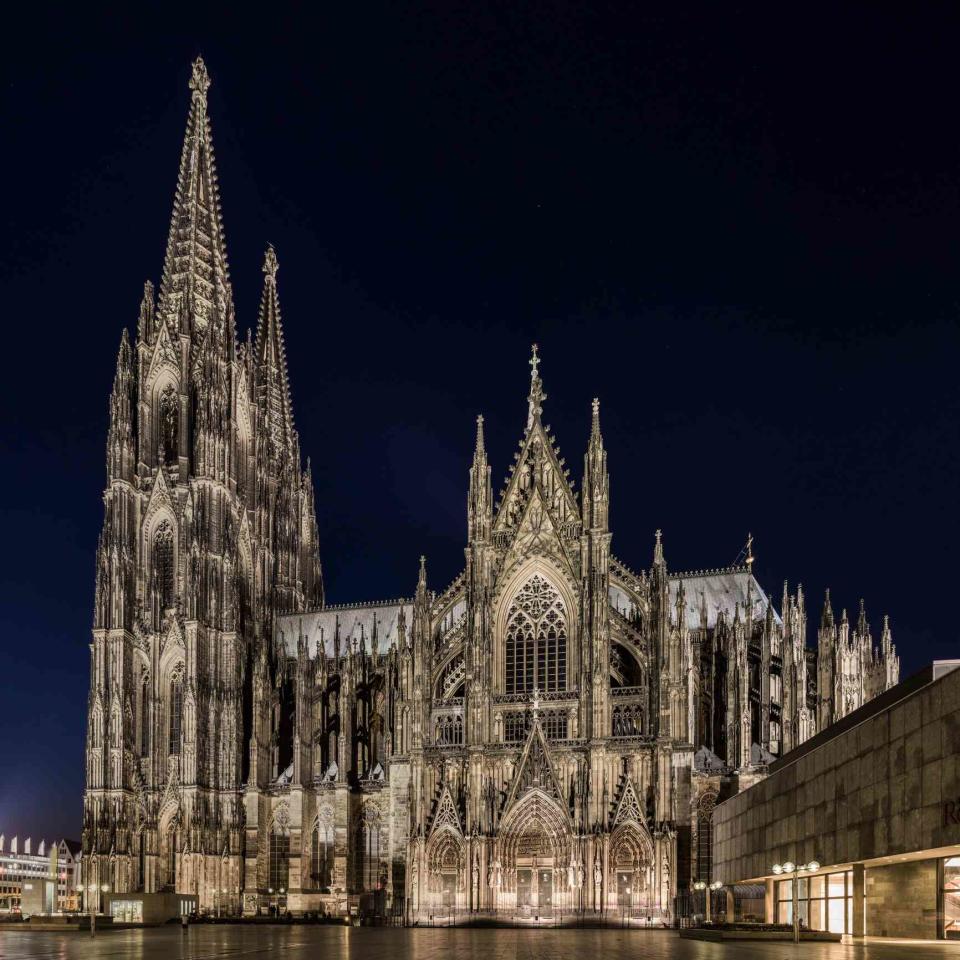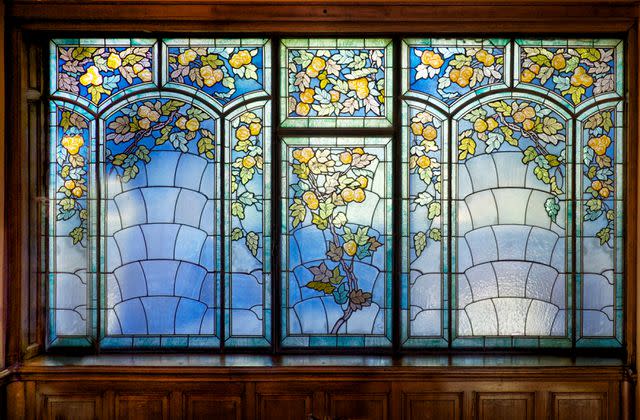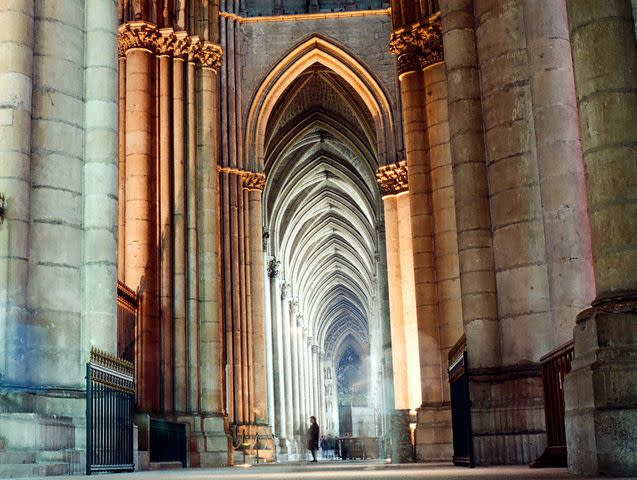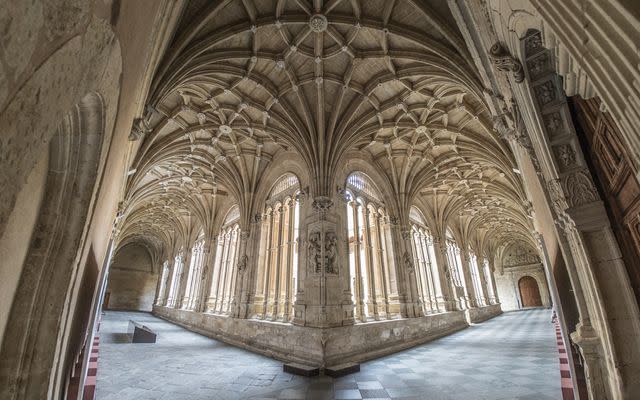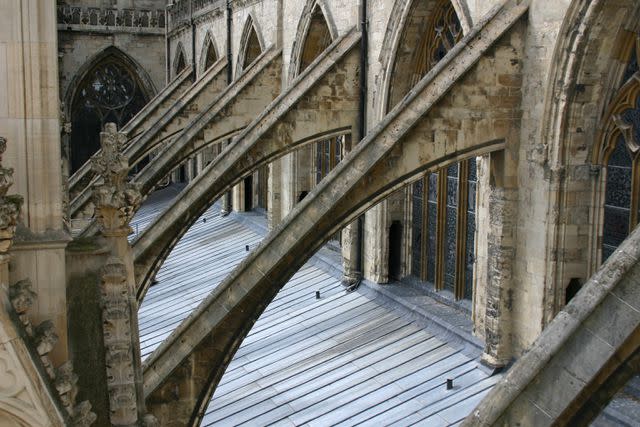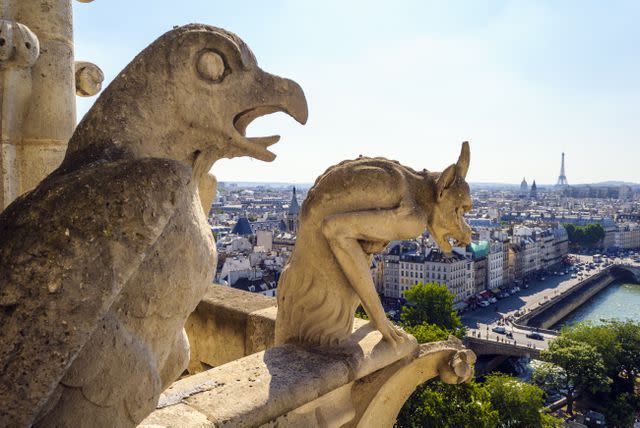Architectural type originating in the mid-12th century in cathedrals & churches
Fact checked by Emily Estep
Well-known for its pointed arches, flying buttresses, and large, stained glass windows, Gothic architecture is a European architectural type that originated in the mid-12th century and remained popular until the 16th century. Often employed for churches, cathedrals, and other massive stone buildings, Gothic architecture became extremely popular across its origin country of France, as well as the rest of Europe and the world.
Although the type of Gothic architecture that was used to construct a building is based on the building's age, location, and building type (for example, a church), all Gothic structures share five key elements: stained glass windows, pointed arches, flying buttresses, ribbed vaults, and highly ornate decoration.
It's rare to find a personal dwelling built in the Gothic style—although, they definitely do exist—but Gothic architecture essentially defined European construction and decoration for four centuries. Read on to learn more about gothic architecture, including its history, must-have architectural elements, and where to find concentrations of gothic architecture.
25 Gothic Bedroom Ideas That Combine Moodiness With Killer Style
The History of Gothic Architecture
As previously mentioned, Gothic architecture originated in France—where it was originally called "Opus Francigenum," or "French Work." Beginning in the mid-12th century, advancements in structural engineering enabled French builders to create massive structures. Some of the key elements of Gothic architecture—like large, stained glass windows and vaulted arches—allowed ample natural light into the structures, despite their massive size and height. This style dominated European architecture—especially structures built by the Roman Catholic church—until the 16th century, when it became known as Gothic architecture.
Over time, Gothic architecture evolved through phases:
The High Gothic years, which lasted from 1250 to 1300 and was first introduced by Chartres Cathedral in France. This time period was defined by Rayonnant style, or highly ornate decorations on the buildings' exterior. Germany, Spain, and Britain created their own variations of Rayonnant Gothic architecture over the next several decades.
The Late Gothic years, which lasted from the 15th to 16th centuries. During this time, Germany produced massively tall churches with vaulted ceilings. British Perpendicular Gothic architecture (identified by a focus on vertical lines) and French Flamboyant style (extremely elaborate exterior decoration) were popular during this time as well.
Although Gothic architecture has many Romanesque characteristics, Gothic builders abandoned the very thick, solid walls produced by the Romans. Why? In order to build extremely tall structures, walls had to be thinner and weigh less. What's more, Gothic-era builders used flying buttresses—or an inclined beams that support the weight of a structure—in order to build structures that appeared to touch the sky.
It's rare to find new construction built in the Gothic style, but a European vacation—or a trip to New York City, Washington D.C., and other major cities in the United States—can provide an excellent tour of this architectural style's history, as well as Gothic Revival.
Must-Have Elements of Gothic Architecture
As previously mentioned, the type of Gothic architecture used to produce a building depends on the structure's age, location, and usage. However, all Gothic buildings share these distinguishing characteristics:
Stained glass windows
It's common to find stained glass windows in places of worship, but they're extremely prevalent in Gothic churches and cathedrals. The windows are usually very tall and arched, or round, and were intended to let in as much natural light as possible. You'll often find tracery, a decorative, stone support, as well as biblical scenes in Gothic stained glass windows.
Pointed arches
Rather than using round, Romanesque arches, Gothic builders built tall, thin, pointed arches. Inspired by Islamic architectural styles, Gothic pointed arches accentuated ceiling heights, accommodated vaulted ceilings, and symbolically pointed towards the heavens. You'll also find these types of arches in Islamic architecture.
Ribbed vaults
In order to build extremely tall structures with tall windows, Gothic architects began to use ribbed vaults—or arched vaults placed parallel to each other to support a rounded roof—rather than traditional vaulted beams. Not only did these intersecting vaults create visual interest, but also they offered more support to tall Gothic structures.
Flying buttresses
Flying buttresses were another Gothic-era advancement that helped support tall, heavy Gothic buildings. Flying buttresses are shaped like half of an arch and offer support by redistributing weight from a higher, heavy level, to a lower, more solid level.
Decorative elements
Gothic architecture is characterized by extremely ornate exterior decoration. Embellished columns, moldings, statues, pinnacles, spires, and gargoyles that spout water are commonly found in Gothic architecture.
33 Stair Riser Ideas to Elevate Your Space
Where to Find Gothic Architecture
Personal homes are rarely built in the Gothic style, but visits to some of the world's major cities can offer a glimpse into some of the oldest—and most elaborate—architecture in the world. Gothic architecture originated in France and then spread across Europe, where you'll find it used most widely. In addition to France, you can also find Gothic architecture in Great Britain, Spain, and Germany.
Examples of Gothic Architecture
Here are some famous Gothic structures from around the globe:
Westminster Abbey
This royal church in London, England built in 1090 is also a World Heritage Site.
Notre-Dame Cathedral
The famous cathedral in Paris, France is considered a symbol of the French nation. It was built in 1163.
Duomo di Milano
Milan's Duomo began construction in 1386 and is Italy's largest church.
Cathedral of Barcelona
This Spanish cathedral was constructed from the thirteenth to fifteenth centuries. It is the seat of the Archbishop of Barcelona.
St. Stephen's Cathedral
Established in Vienna, Austria in 1137, St. Stephen's Cathedral is the tallest church in Austria and the seat of the Archbishop of Austria.
St. Patrick's Cathedral
Set on 5th Avenue in New York City, St. Patrick's Cathedral was constructed in 1858 and is a Neo-Gothic-style Roman Catholic church.
Washington National Cathedral
This D.C. landmark was built in 1907 and is the sixth largest church in the world.
The Tribune Tower
Chicago, Illinois's Tribune Tower is a 463-foot-tall skyscraper built between 1923 and 1925.
Trinity Church
Manhattan's Trinity Church was built in 1696 and is the burial spot of Alexander Hamilton.
Cathedral of Learning
Built in Pittsburgh, Pennsylvania in 1926, the Cathedral of Learning is a 42-story skyscraper on the University of Pittsburgh's main campus
Frequently Asked Questions
What defines Gothic architecture?
Gothic architecture is defined by arches, buttressing, stained glass, ornate decoration, and vaulted ceilings. You'll also find a lot of exterior embellishments in columns, moldings, spires, and statues.
Why is it called Gothic style?
Gothic style earned its name from Italian Renaissance writers who attributed it to barbarian Gothic tribes that destroyed the Roman Empire. It was a derogatory term at the time.
How is Gothic architecture different from Romanesque?
Gothic architecture differs from Romanesque as it features thinner walls and pointed arches. Romanesque architecture, by contrast, is characterized by heavy walls and rounded arches. You'll also find stained glass and buttressing in Gothic architecture, which is not characteristic of Romanesque.
Read Next: 32 Popular Architectural House Styles
Read the original article on The Spruce.
